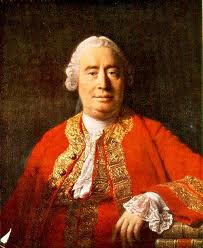- Born in Scotland (1711-1776)

- Adopted and refined some of Locke’s theories
- In addition to philosophy, was a historian and essayist
- Some call him “the most important philosopher ever to write in English”
Hume’s Answer to the Quarter Experiment:
When you are observing something, like a quarter, for instance, you are not observing the quarter but your sense impressions of the quarter
Hume’s Theory of Knowledge:
| Perceptions
All knowledge originates with experience, and all experience is of one’s own perceptions. We have direct knowledge only of perceptions, not of what the perceptions are of (if, indeed, they may be counted as of anything); for the perception stands between the perceiving mind and its supposed real-world object. There are two kinds of perceptions: |
| Ideas
-Pale copies of impressions -Faint images which occur in thought and reasoning -Material for thinking- includes thought, reflection, and imagination |
| Impressions
-Vivid or lively sensations -Immediate data of experience -Impressions enter the mind with “force and violence”. -Can include sensations, passions, and emotions |
Furthermore, perceptions can either be simple or complex. Simple perceptions composed of a singularity, or one specific quality (hot), whereas complex perceptions are composed of many qualities (fire: hot, red, orange, etc.)
Simple ideas enter the mind as copies of our impressions. Complex ideas are composed of many simple ideas.
First we have sensations; these lead to impressions that lead to ideas. We have no ideas unless they are derived from impressions.
Hume’s Answer to the Billiard Ball Experiment:
Most thinkers (like rationalists) believed causality enables humans to reason beyond their sense perception. However, Hume had a problem with unseen events. Why do we believe there is such thing as cause anyway?
Hume believed there was no necessary connection between any cause and any effect, only an expectation in the mind which was a figment of the human imagination. People embrace the idea of causal connections because it helps them make sense of the world, but no one can prove causality exists. No one has any rational knowledge of cause.
For example, Hume believed there is no necessary connection between flame and heat in the real world. It only exits in our minds.
Hume’s position is called phenomenonalism. This is the view that all we actually know is the appearances presented to us in our own perceptions.
Hume’s Basis of Knowledge:
| Relations of Ideas | Matters of Fact |
| Ideas that simply by virtue of their meanings and relations are necessarily or logically true, but therefore irrelevant to the world of reality; for example, “The sum of the angles of a triangle equals 180 degrees.” | Ideas that bear upon and inform us about the world of reality, but that can never be certain because they are derived from specific experiences. For example, “Water freezes at 32 degrees Fahrenheit” or “The sun will rise tomorrow.” |
